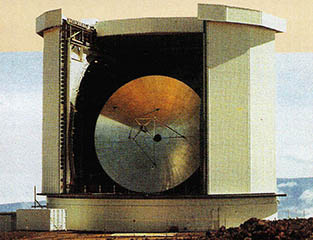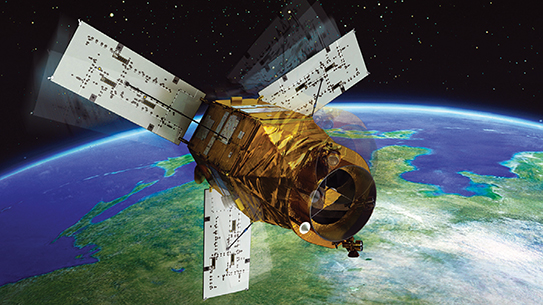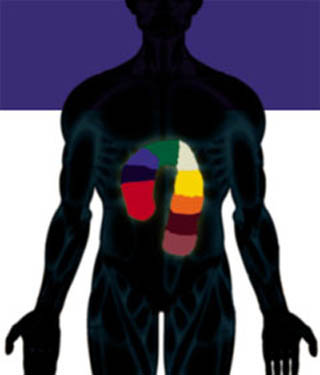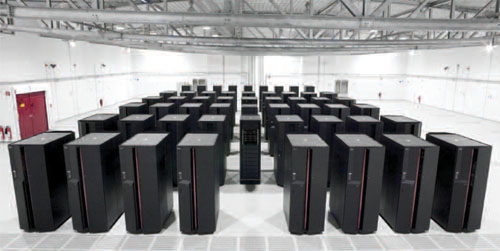만약 우주에 반(反)물질과 같은 것이 있다면 과학자들은 그것을 검출하는 방법을 곧 알아낼 것이다.
한때 과학자들은 반물질이 반드시 존재해야 한다고 생각했었다. 생성된 모든 물질에 대해 그 만큼에 상응하는 반물질도 생성되어 있어야만 했기 때문이다. 그 둘은 서로 반대일 것이다. 물질이 양전하를 갖고 있는 곳에서는 반물질이 음전하를 갖고 있고, 혹은 그반대 일수도 있다.
북쪽을 가르키는 자장을 갖고 있는 물질이 있는 곳이라면 남쪽을 가르키는 반물질이 있고 그 반대의 경우도 있다.
같은 양의 물질과 반물질이 서로 만난다면 그들은 동일질량의 융합물질로 이루어진 수소폭탄의 약 백 배의 위력으로 폭발하면서 서로를 없애고 사라진다.
과학자들은 실험실에서 극히 소량의 반물질 파편들을 만들어 낼 수 있지만 우리주위의 자연계에는 단지 물질만이 있을 뿐이다. 달도 역시 물질이다. 그렇지 않으면 우주비행사들이 반물질인 달에 접촉할 때 그들은 폭발했을 것이다. 화성도 물질이다. 그렇지 않으면 바이킹 탐색선도 폭발했을 것이다. 사실 우리는 태양계 전체가 물질이라는 것을 확신하고 있다. 다른 별들이나 은하는 어떠할까? 아마도 반물질로 이루어진 반항성과 반은하가 있을지도 모르며 우주에는 서로 다른 장소에 위치한다는 사실만을 제외하면 같은 양의 물질과 반물질이 존재할 지도 모른다.
그렇다 할지라도 그들을 따로 떼어 놓는다는 것은 어려울 것이다. 여기저기 먼지와 가스의 구름이 흩어져 있고 그들은 때때로 부딪쳐 상호작용을 하지않을 수 없게된다. 만약 어떤 물질구름이 따로 반물질구름을 만난다면 특정형태의 에너지를 가진 감마선의 폭발이 있을 것이나 아직 그러한 폭발은 발견되지 않았다.
사실 과학자들은 주저하면서 우주는 거의 모두가 물질로 구성되어 있다고 결론지었고 태초의 탄생에서 어떻게 반물질에 비해 약간 많았던─10억대1의 비율로─물질이 생성되어졌나를 설명할 수 있는 이론을 고안해 내었다. 그러한 약간의 초과로부터 우리가 알고 있는대로의 우주가 형성된것이다.
하지만 우리는 확신할 수 있는가? 어딘가에 현존하는 수천억의 은하중 반은하가 있을 수도 있지 않은가? 혹은 적어도 뜻하지 않은 반행성 하나라도 있지 않을까? 우리가 탐구할 수 있는 먼 행성이나 은하로부터 우리에게 도달하는것으로 어떤 단서가 될수 있는 것이 있지 않을까?
우주선입자는 모든 방향으로부터 우리에게 도달한다. 그들은 거의 완전히 물질이며 극히 미량의 반물질 파편을 갖고 있으나 이것은 우리에게 별 도움을 주지 못한다. 우주선입자는 전하를 띠고 있어서 우주공간을 통과할 때 곡선경로를 따른다. 만약 우리가 우주선에서 반물질입자의 폭발을 찾아낸다 할지라도 우리는 그들이 어디에서 왔는지를 알 수 없다. 우리는 그 근원을 확인할 수 있도록 전하를 띠지 않아 직선경로를 여행해 온 중성입자를 조사할 필요가 있다.
외계로부터 우리에게 도달하는 중성입자는 3가지 유형이 있다. 첫째는 ‘광자’로 전파는 물론 X-선, 감마(γ)선, 일반광선 등으로도 에너지를 운반한다. 그들은 모든 별, 은하로부터 막대하게 우리에게 도달하지만 별 소용이 없다. 반광자와 같은 것은 없다. 물질과 반물질이 모두 똑같이 광자를 방출한다. 이것은 우리가 조용한 반행성이나 반은하를 단순히 그들이 우리에게 보내는 빛의 종류를 조사함으로써 확인할 수 없다는 것을 뜻한다.
중성입자의 두번째 종류는 ‘중력자’이다. 중력자 역시 모든 별이나 은하로부터 막대한 양이 도달하지만 에너지를 거의 가지고 있지 않기 때문에 현재까지 그들을 검출해 내기는 불가능했다. 우리가 그들을 검출할 수 있을지라도 아마 반중력자와 같은 것은 없을 것이기 때문에 역시 우리가 반행성을 찾는데 도움을 주지 못할 것이다.
중성입자의 세번째 종류가 남는다. 즉 ‘중성미자’이다. 중성미자는 질량과 전하를 거의 가지고 있지 않은 미세한 아원자입자이다. 그들은 물질과 거의 상호작용을 하지 않는다. 그러나 한편 반중성미자와 같은 것이 존재한다. 물질로 이루어진 항성과 은하는 다량의 중성미자를 방출하는 반면 반물질로 된 반항성과 반은하는 다량의 반중성미자를 방출한다. 불행히도 중성미자와 반중성미자는 별과 은하로부터 우리에게 도달한 것들이 항상 우리를 스쳐 지나가므로 검출하기가 어렵다.
그러나 때때로 초신성이 폭발하고 그첫번째의 격렬한 폭발에서 초신성이 물질로 이루어져 있다면 막대한 양의 중성미자를 방출하게 되고, 반물질로 이루어져 있을 경우 막대한 양의 반중성미자를 방출하게 된다. 1년전에 대마젤란성운에서 폭발한 것으로 보여졌던 초신성은 약 ${10}^{36}$개 입자의 거대한 폭발물을 방출하였고 그 중 19개만이 지구에서 검출되었다. 그것이 우리 태양계를 벗어난 곳으로부터의 어떤 입자들이 검출되기로는 처음이었다. 그들은 중성미자였으며 그래서 마젤란 초신성은 물질로 구성되어진 것으로 여겨진다.
그러나 보다 강력하고 섬세한 중성미자 탐지기를 고안하려는 계획이 추진중에 있다. 초신성으로부터의 폭발이 기계적으로 쉽게 수신되고 분석되어질 때가 올지도 모른다.(우리의 은하에서만 1년에 약 10개의 초신성이 있는 것 같고 근처의 다른 은하들에서도 같다)
사실 모든 폭발들이 중성미자일지도 모르며 아마도 중성미자일 것이리라. 그럼에도 불구하고 만약 한번, 단 한번만이라도 반중성미자의 폭발이 감지된다면 우리는 반행성(아마 반은하에 존재하는)을 발견했다는 사실을 알게 될 것이고 그것은 우리가 우주의 성질, 그 탄생과 죽음에 대해 가지고 있던 개념을 재평가하는 것을 도와줄 것이다.
If there is any such thing as antimatter in the universe, scientists may soon have a way of detecting it.
At one time, scientists thought there had to be antimatter. For every bit of matter created, an equivalent bit of antimatter ought to have been created. The two would be opposites. Wherever matter has a positive electric charge, antimatter has a negative one, and vice versa. Wherever matter has a magnetic field pointing north, antimatter has one pointing south, and vice versa.
If quantity of matter and antimatter encounter each other, they cancel, annihilating each other in an explosion a hundred times as powerful as that produced by a hydrogen bomb with fusing material of the same mass.
Scientists can produce tiny fragments of antimatter in the laboratory but in the natural world, we have about us only matter. The moon is matter, too, or our astronauts would have exploded when they touched it. Mars is matter, or the Viking probes have exploded. In fact, We are quite certain the entire solar system is matter.
What about other stars, or other galaxies? Perhaps there are antistars and antigalaxies made up of antimatter, and maybe there are equal quantities of matter and antimatter in the universe, except that they exist apart in different places.
Keeping them apart would be difficult, though. There are clouds of dust and gas, here and there, and they are bound to collide and interact on occasion. If a matter-cloud encountered an antimatter-cloud, there would be bursts of energetic gamma-rays of a particular type, but no such bursts have ever been seen.
In fact, scientists rather reluctantly have concluded that the universe is just about all matter, and have worked out theories to explain how, in the original creation, a slight excess of matter over antimatter was produced in the ratio of a billion to one. Out of that slight excess, the universe as we know it was formed.
But are we sure? Might there not yet be antigalaxies somewhere among the hundred billion galaxies or so that exist, or an occasional antistar at least? How else could we tell? Is there anything that reaches us from distant stars and galaxies that we can study that might give us a clue?
Cosmic ray particles reach us from every direction. They are almost entirely matter, with only a tiny fraction of antimatter, but they don't help us. Cosmic ray particles carry an electric charge and therefore follow curved paths through space. Even if we detected a burst of antimatter particles in the cosmic rays we couldn't tell where they came from. We need to study unchargd particles that travel in straight lines so that we can identify their sources.
There are three types of uncharged particles that reach us from outer space. First are “photons,” which carry the energy in ordinary light, as well as radio waves, X-rays, gamma rays and so on. They reach us in enormous quantities from every star and galaxy - but they are useless. There are no such things as “antiphotons.”Matter and antimatter alike emit photons. This means we can never identify a quiet antistar or antigalaxy by simply studying the kind of light it sends us.
A second type of uncharged particle is the “graviton.”Gravitons reach us in vast quantities, too, from every star and galaxy, but they carry so little energy we have so far been unable to detect them. Even if we could detect them, there are probably no such things as “antigravitons” so they wouldn't help us detect antistars either.
That leaves a third type of uncharged particle - the neutrino.
Neutrinos are tiny subatomic particles with almost no mass and with no charge; they have almost no interaction with matter. But there is such a thing as an antineutrino as well. Stars and galaxies made up of matter give off quantities of neutrinos, while antistars and antigalaxies give off quantities of antineutrinos. Unfortunately, neutrinos and antineutrinos are so difficult to detect that those reaching us from stars and galaxies usually pass us by.
However, every once in a while a supernova explodes and, in its first fury, it emits an enormous burst of neutrinos, if it is composed of matter - or an enormous burst of antineutrinos, if it is composed of antimatter. The supernova that was exploding in the Large Magellanic Cloud nearly a year ago sent out such an enormous burst of trillions upon trillions upon trillions of particles, and 19 of them were detected on Earth. That was the first time any such particles were detected from beyond our solar system. They were neutrinos, so the Magellanic supernova seems to be composed of matter.
However, plans are afoot to devise more powerful and delicate neutrino detectors. The time may come when bursts from supernovas will routinely be received and analyzed. (There may be 10 supernovas a year in our galaxy alone and equal numbers in other galaxies nearby.)
It may be-in fact, it probably will be-that all the bursts will be of neutrinos. Still, if once, just once, a burst of antineutrinos is detected, we will know we have found an antistar (existing, perhaps, in an antigalaxy), and that may help us re-evaluate our notions of the nature of the universe and possibly of its birth and death.
이 기사의 내용이 궁금하신가요?
기사 전문을 보시려면500(500원)이 필요합니다.
1988년 04월 과학동아 정보
🎓️ 진로 추천
- 물리학
- 천문학
- 항공·우주공학

















